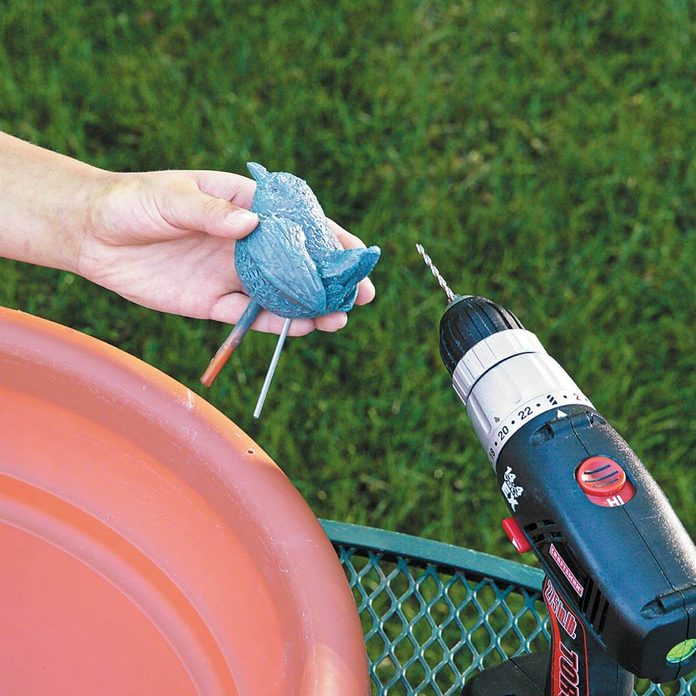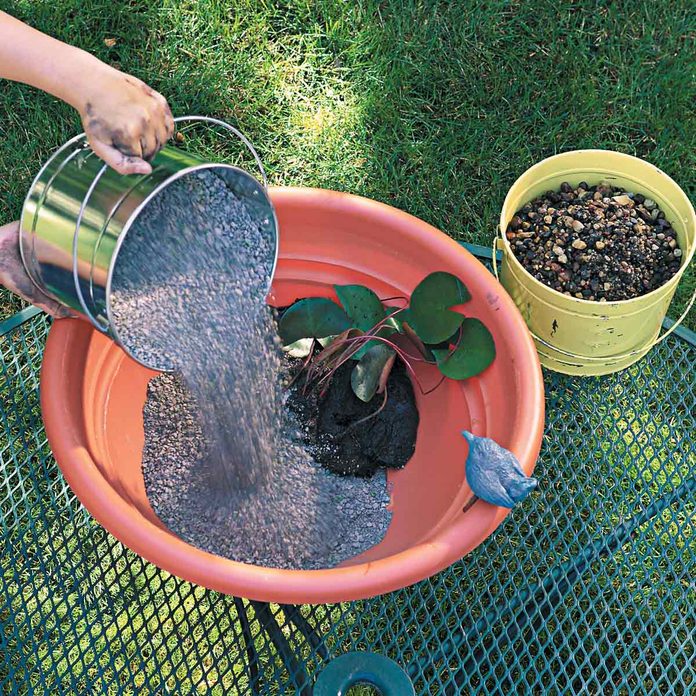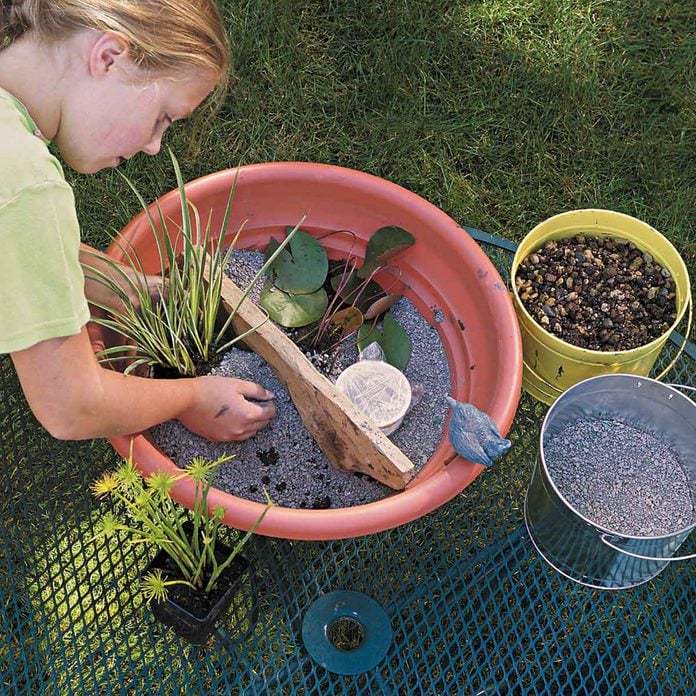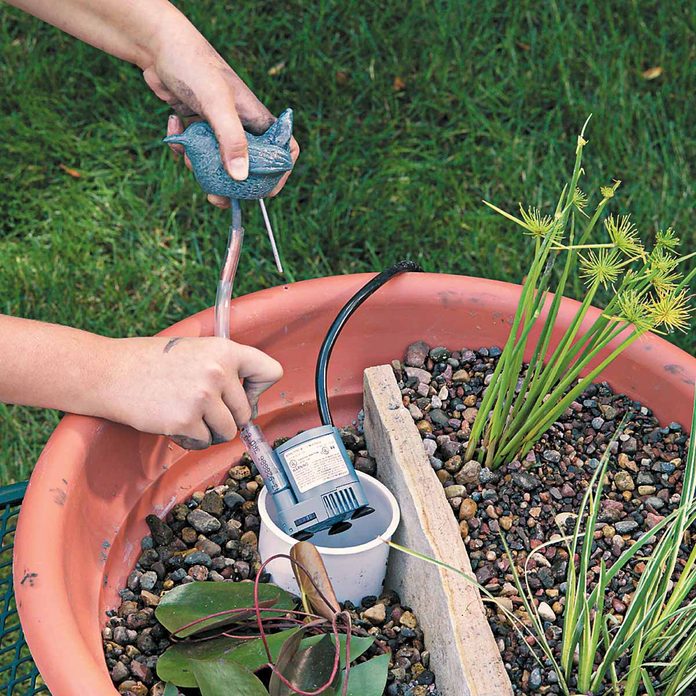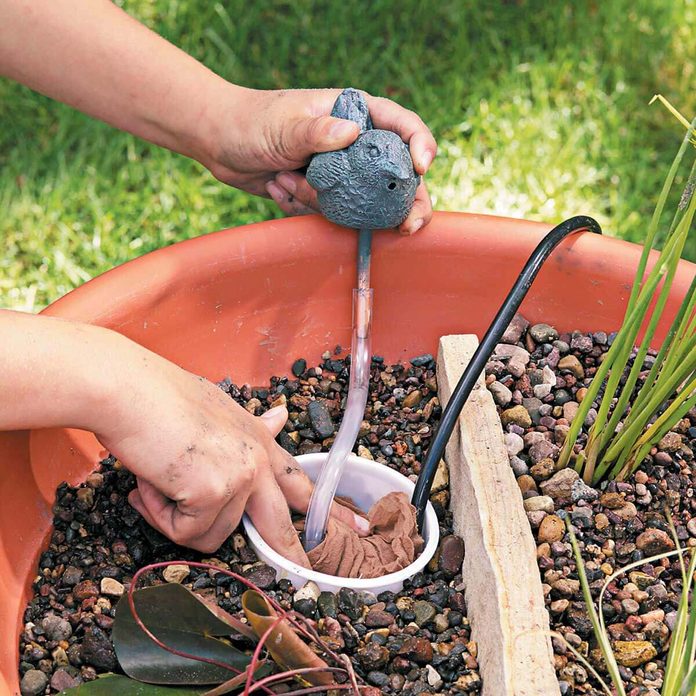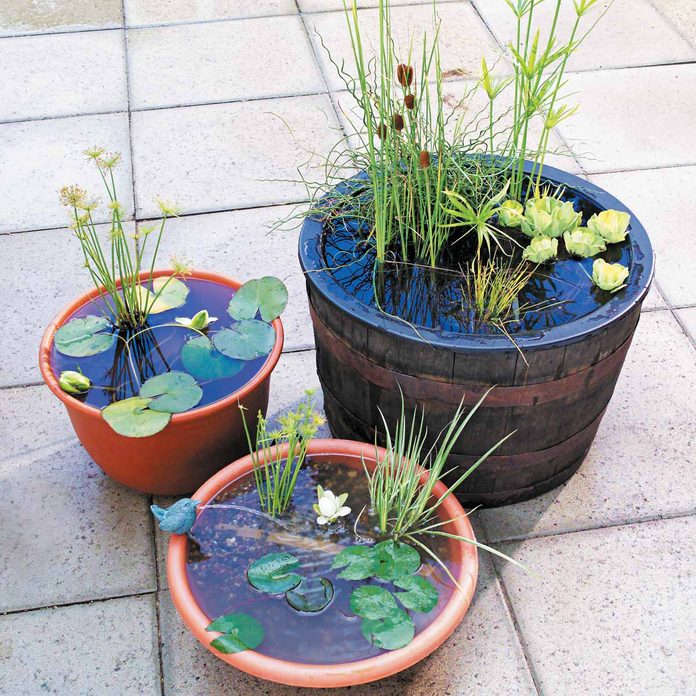Pint-Sized Water Gardens
Updated: Feb. 17, 2023Mini ponds perfect for patios or decks.
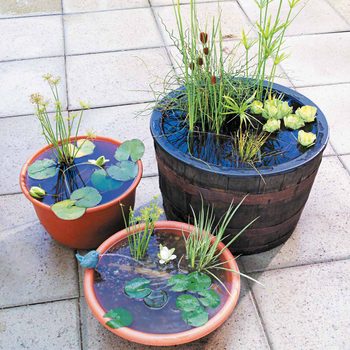
Pint-Sized Water Gardens
These pint-sized water gardens are extremely low maintenance. Top them off with water before you go on vacation, and they’re still beautiful when you come home. Container water gardens are inexpensive and easy to build, too. So here’s how to get into the swim of things with a container water garden.
What You Need:
For a basic garden, you need at least an 18- to 20-in. plastic container that’s 7 to 8 in. deep, a small submersible pump, a spouting ornament, plants, clear vinyl tubing, clean kitty litter, pea gravel or small pebbles and a nylon stocking. Most items are readily available at larger garden centers or on-line (see “Supplies and Books”, in Project PDFs below).
How to Do It:
The photos below will show you how. Here are a few additional tips:
- The floor is two tiered to allow for different types of plants; the lilies planted on the deep side have stems that float upward and extend horizontally, while the “marginal” plants—those that grow upright and favor shallower water—stand on the higher side. The partition that separates the two sides can be made from stone, bricks or other heavy material.
- Pea gravel both beautifies your water garden and acts as a lid over the un-potted soil so it can’t circulate and darken the water. Rinse the pea gravel before adding it to the container.
- For extra protection, place the pump in a nylon stocking before putting it in the cup, then stuff the extra nylon over the pump. This filtering is crucial; otherwise, pebbles and kitty litter will be drawn into the pump and clog it. A well-filtered pump will run for them sit for a day or two to allow chlorine to evaporate and water temperature to moderate. Pour the water in gradually—it should be as clear as a mountain stream.
- Aquatic plants thrive on direct sunlight, so a bright sunny spot is ideal. If possible, position the container near an electrical outlet for the pump. Wind can wreak havoc with tall plants by pushing the containers off their pedestals. Finding a wind-free space helps solve this problem and ensures the fountain arc from the spouting ornament looks and sounds the way you want it to.
Project Directions:
1. Mount Spouting Ornament
Drill a small hole in the rim of the container to mount the spouting ornament. If you need to bend the support spike to level or position the spouter, grip it with two pairs of pliers so you don’t crack the ornament.
2. Spread Kitty Litter
Spread the soil of the lily or other deep-water plants in one half of the container, then add kitty litter to create a level floor.
3. Plant Shallow-Growing Plants
Add a partition to divide the container into halves. Plant the shallow-growing marginal plants and spread more kitty litter over the soil. On the low side, nestle a plastic cup for the pump in the kitty litter, keeping it covered with plastic to prevent gravel from falling in.
4. Spread Pea Gravel
Spread pean gravel over the kitty litter. Keep the floor on the lily side lower to allow the lily stems room to extend upward when you add water.
5. Add Vinyl Tubing Connector
Connect the pump to the spouter with vinyl tubing. Use a transition piece of 1/2-inch tubing if necessary to connect the 3/8-inch tube to the pump. Press the pump into the cup so that the suction cups anchor it to the bottom.
6. Nylon Stocking Filter
Cover the pump with a nylon stocking filter to keep gravel from clogging the pump, and then cover the pump with pea gravel.
Care and Maintenance:
Taking care of water gardens is a breeze. Top them off as water evaporates and scoop off the occasional dead leaf or bit of algae. Plants maintain water clarity by absorbing decaying matter through their roots as food. But if the water starts looking gunky, remove the plants, rinse the container and refill.
For any plants needing a boost, press a fertilizer pellet into the potting soil. You can also add a Mosquito Dunk (about $1 each at garden centers) a couple times in the summer to kill mosquito larvae without posing harm to people or pets. Smaller containers will only need a small piece.
You can overwinter hardy water lilies by wrapping them in a damp towel and storing them in a cool basement or garage corner. Other plants are relatively inexpensive and grow rapidly, so in cold climates, buy them anew each year and treat as annuals. For a small container, plant a dwarf lily so the pads don’t completely cover the surface of the water as they grow. For larger water gardens, you can add a floating plant like water hyacinth, duckweed or water lettuce.
A dish-style garden is too small for koi or goldfish, but larger containers, like whiskey barrels or larger terra-cotta pots, are ideal. (Note: Water in metal containers usually gets too warm for fish.) Fish help keep the garden clean by eating algae, decaying plant material and mosquito larvae. Make certain to read up on fish so you give them the proper care and learn how they will impact your garden. Plus, check out how to safely deter animals that steal from your garden.
Supplies and Books
Pump: Rena AT75 Water Pump, $19 at www.planetrena.com.
Spouting large wren ornament: $19, Maryland Aquatics, (877) 736-1807.
Water Gardening in Containers by Helen Nash and C. Greg Speichert.
Simple Fountains for Indoors & Outdoors: 20 Step-By-Step Projects by Dorcus Adkins.
Container Water Gardens by Philip Swindells.
